Qsan AegisSAN Q500-P20-D424 review
An ideal IP SAN solution for SMBs with big growth plans for the future
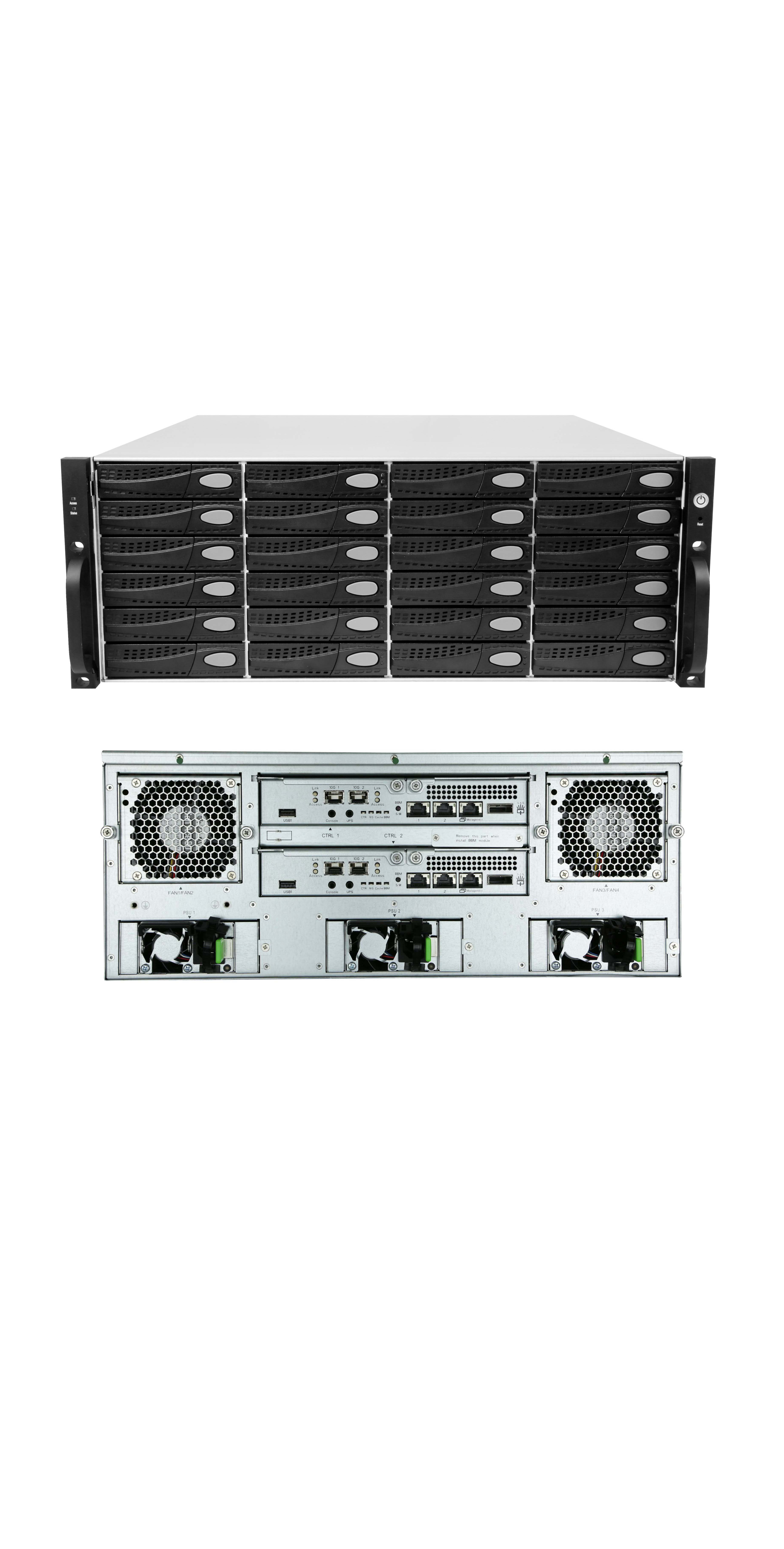

Qsan’s IP SAN array combines big capacity with enterprise features at an SMB price. Dual active controllers, fast failover and total redundancy make it perfect for storing business critical data.
-
+
Top value; Active/active controllers; Huge expansion potential; Good performance; Transparent failover
-
-
MUX interposers required for SATA drives

Qsan has a reputation for delivering affordable IP SAN arrays with high expansion potential and it has done it again with its latest AegisSAN Q500-P20-D424. This imposing 4U system gets you started with 24 SAS/SATA hot-swap bays and can be expanded up to 256 drives using Qsan's J300Q external disk shelves.
SMBs will like its price tag as our diskless review system with dual 10GbE-enabled controllers costs just 6,328 ex VAT. Even better, both controllers function in active/active mode and provide fast, transparent failover.
The P20 controllers each provide two 10GbE SFP+ and dual Gigabit Ethernet data ports along with dedicated Gigabit management ports. To cut costs, you can start with one controller and upgrade later on. Qsan also offers models with six Gigabit Ethernet, dual 8/16Gbps FC or dual 6Gbps SAS ports.
Top tolerance
Hardware fault tolerance is excellent as the array doesn't have a single point of failure. You get triple 550W hot-plug PSUs, plus dual cooling fan modules. Qsan also offers an optional cache memory battery backup pack.
Both controllers have 6Gbps SAS expansion ports so the J300Q disk shelves can be daisy-chained over dual links. These also have dual hot-plug power supplies and cooling fans.
You don't have to swap out the controllers if you want different data ports as they can be upgraded in the field. The kit comprises a daughtercard, SATA DOM plus a new backplate. We upgraded a P10 Gigabit model to the P20 10GbE version on review in around 30 minutes.
We had no problems deploying the array in our lab as Qsan's QFinder located it for us and provided direct access to its web interface. We also used Qsan's QCentral Java app which can manage multiple AegisSAN and TrioNAS appliances from a single interface.
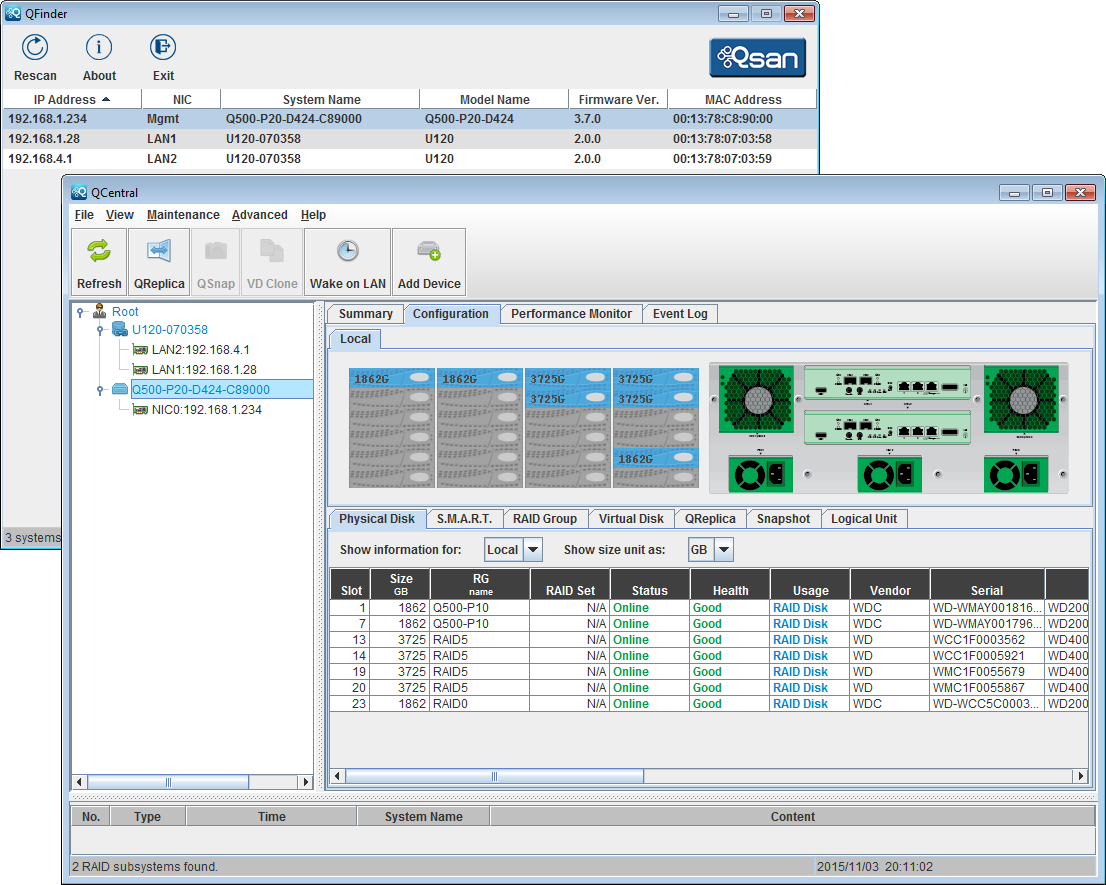
Qsan provides plenty of quality management tools for the array
Disk and RAID support
For testing, we loaded up four 4TB WD Enterprise SAS drives. For SATA drives, you'll need Qsan's MUX interposer boards. We found them easy to fit on the back of the drives carriers, but their price tag of 30-40 each does nullify the cost savings of cheaper SATA drives.
Storage provisioning is easy enough and we started by creating a RAID Group (RG) using all our SAS drives and choosing an array type. Qsan supports stripes, mirrors, RAID10, 5, 6, 50 and 60 or you can use the wizard which grabs all the drives and chooses an array type for you.
Thin provisioning can be applied to selected RGs and policies used to handle space usage and alerting. Each policy employs six user-defined capacity thresholds that can trigger actions such as an email message, space reclamation, snapshot deletion and, when no more space is available, they can safely take the RG offline. If space gets tight you can install extra drives and add them to the RG on the fly.
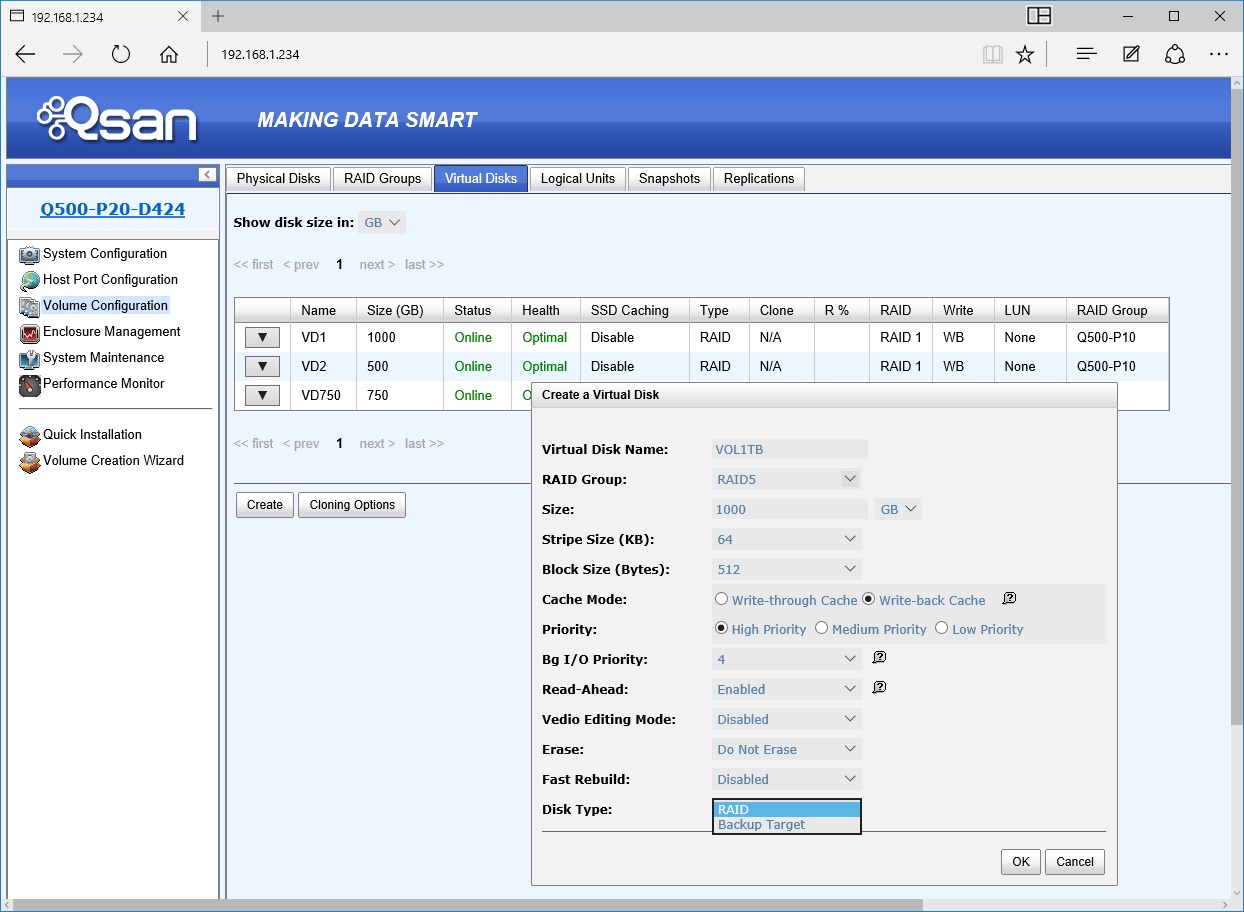
The array's local web console provides full access to all storage features
VDs and performance
IP SAN targets are swiftly provisioned by creating virtual disks (VDs) within an RG and choosing a capacity for each one. When new drives are added to an RG, the VD can be expanded into them.
We attached each VD to a LUN and could decide which of our host initiators were allowed to see them. Global access is enabled simply by using a wild card and we could set each LUN as read only or read/write.
To test performance, we used an HP ProLiant DL380 Gen9 rack server equipped with an Emulex dual-port 10GbE adapter and running Windows Server 2012 R2. With it logged in to a 750GB target, we saw Iometer report good raw read and write speeds of 1,060MB/sec and 809MB/sec which equates to 8.3Gbits/sec and 6.3Gbits/sec.
With a dual 10GbE MPIO link across both controllers, we tested failover by firing up Iometer and then pulling out the primary controller. The test continued unabated (albeit at the speed of a single link) and when we plugged the controller back in, the array spotted it and enabled full redundancy in less than 60 seconds.
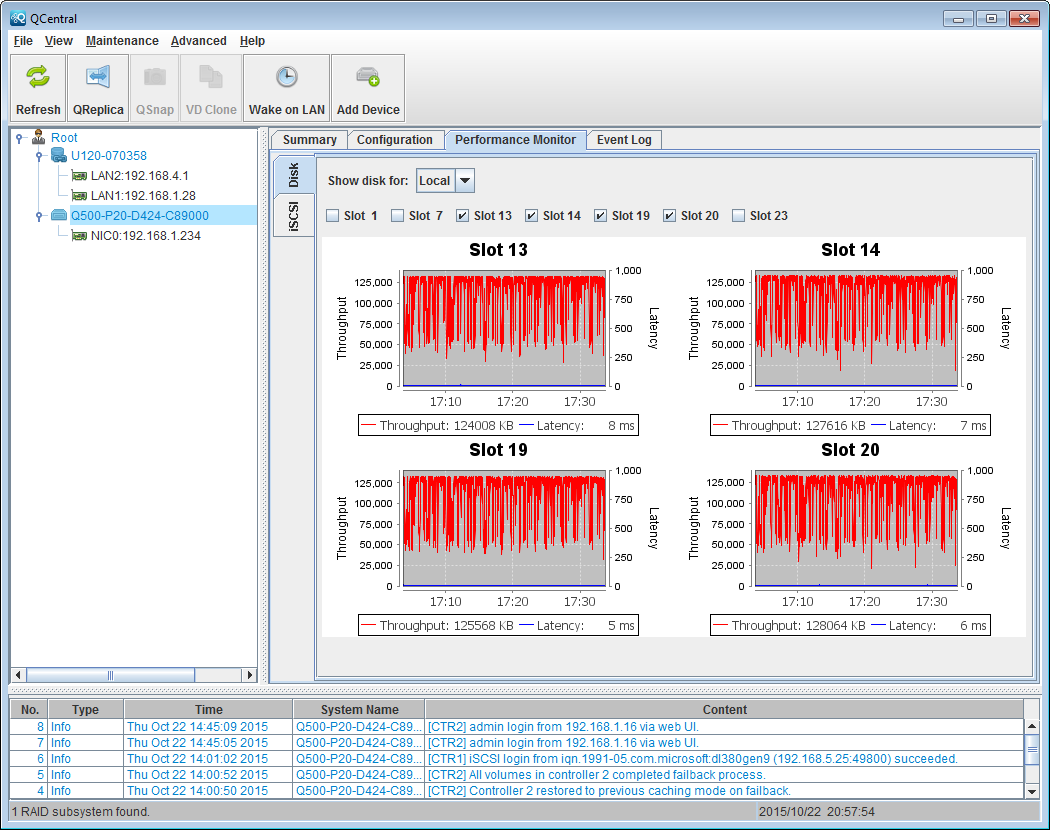
We could keep a close eye on performance from the QCentral console
Snapshots and clones
We used the web interface and QCentral to configure snapshots for selected VDs, run them on-demand and schedule them for 15-minute, hourly, daily, weekly and monthly intervals. Both interfaces provide lists of existing snapshots which can be exposed as new read-only or read/write targets and assigned to specific hosts using the handy auto-map feature.
Data recovery is a cinch. To test this, we deleted all the data in a 500GB target and dismounted it at the host. With the latest snapshot selected, we chose the rollback option from its drop-down menu and had all the data restored in less than 5 seconds.
Clones are just as easy to use as you create a Backup VD that's the same size as the source. When it's ready, select the Set Clone option on the source, choose the Backup VD as the target and either run the job manually or apply a schedule to keep the clone regularly updated with the latest snapshots.
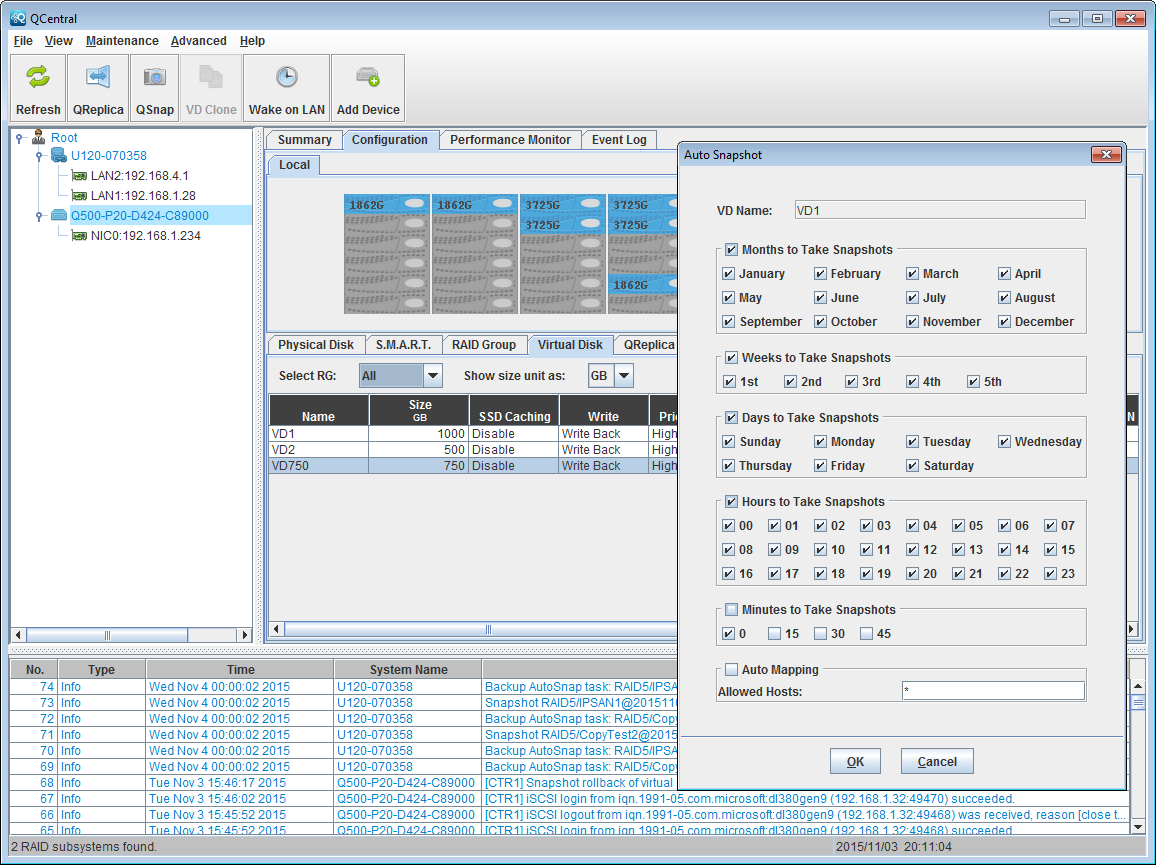
Snapshots can be run on-demand and scheduled at regular intervals
Conclusions
The Q500-P20-D424 delivers fast performance, all-round redundancy and huge expansion potential. If that's not enough, it also has dual active controllers and fast transparent failover at a price the blue chips will have a tough job competing against. It's superb value.
Verdict
Qsan’s IP SAN array combines big capacity with enterprise features at an SMB price. Dual active controllers, fast failover and total redundancy make it perfect for storing business critical data.
Chassis: 4U rack
Storage: 24 x hot-swap LFF/SFF SAS/SATA drive bays
Power: 3 x 550W hot-plug PSUs
Cooling: 2 x hot-plug fan modules
Dual active/active RAID controllers each with:
Processor: 2GHz Atom S1289 SoC
Memory: 4GB DDR3 with battery backup module (max 8GB)
Array support: RAID0, 1, 10, 3, 5, 6, 10, 30, 50, 60
Network: 2 x Gigabit Ethernet, 2 x 10GbE SFP+, 1 x management
Other ports: SAS expansion port
Management: Web browser, QCentral
Get the ITPro daily newsletter
Sign up today and you will receive a free copy of our Future Focus 2025 report - the leading guidance on AI, cybersecurity and other IT challenges as per 700+ senior executives
Dave is an IT consultant and freelance journalist specialising in hands-on reviews of computer networking products covering all market sectors from small businesses to enterprises. Founder of Binary Testing Ltd – the UK’s premier independent network testing laboratory - Dave has over 45 years of experience in the IT industry.
Dave has produced many thousands of in-depth business networking product reviews from his lab which have been reproduced globally. Writing for ITPro and its sister title, PC Pro, he covers all areas of business IT infrastructure, including servers, storage, network security, data protection, cloud, infrastructure and services.
-
 Westcon-Comstor and Vectra AI launch brace of new channel initiatives
Westcon-Comstor and Vectra AI launch brace of new channel initiativesNews Westcon-Comstor and Vectra AI have announced the launch of two new channel growth initiatives focused on the managed security service provider (MSSP) space and AWS Marketplace.
By Daniel Todd Published
-
 Third time lucky? Microsoft finally begins roll-out of controversial Recall feature
Third time lucky? Microsoft finally begins roll-out of controversial Recall featureNews The Windows Recall feature has been plagued by setbacks and backlash from security professionals
By Emma Woollacott Published
-
 The UK government wants quantum technology out of the lab and in the hands of enterprises
The UK government wants quantum technology out of the lab and in the hands of enterprisesNews The UK government has unveiled plans to invest £121 million in quantum computing projects in an effort to drive real-world applications and adoption rates.
By Emma Woollacott Published